Overview
A variety of ships have operated on the Eastern Range. They primarily provided missile tracking data in areas of the Range that ground stations could not cover. Some ships were also used for recovery of missile nose cones and manned spacecraft after splashdown in the ocean.
USS Sarsfield; USS Foss
- Arrived 17 July 1950 to support the Bumper launches with tracking, in-flight data recording and surveillance reporting
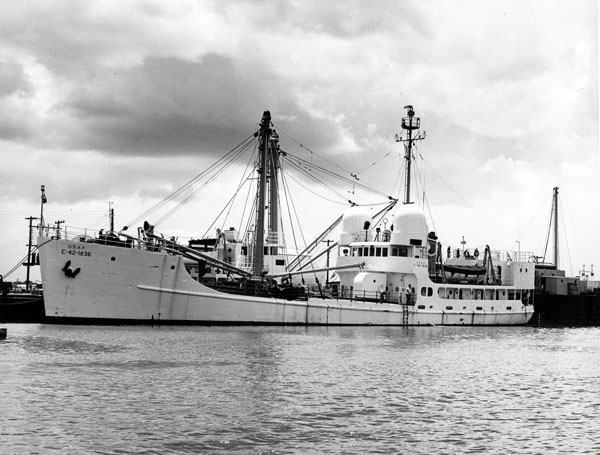
FS Echo; FS Foxtrot; FS Golf; FS Hotel; FS India; FS Kilo
- Converted WWII Freight and Supply (FS) ships
- Also known as Ocean Range Vessel (ORV)
- February 1956 – 11 picket ship were requested to support the Snark and Atlas programs
- 16 April 1956 – Contract awarded to modify WWII surplus ships
- 1957/1958 – Six ships delivered to recover launch reentry vehicles, collect telemetry and weather data between Antigua and Ascension
- November 1959 – Ships retired
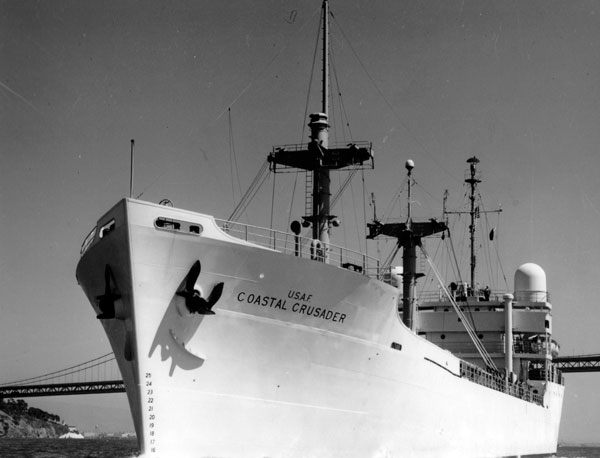
Timber Hitch (T-AGM-17); Coastal Sentry (T-AGM-15); Rose Knot (T-AGM-14); Coastal Crusader (T-AGM-16); Sword Knot (T-AGM-13); Sampan Hitch (T-AGM-18)
- Used primarily for telemetry reception, weather data, and vehicle recovery
- Also known as Ocean Range Vessel (ORV)
- February 1956 – Four ships acquired
- January 1958 – Sword Knot arrived
- March 1958 – Timber Hitch, Rose Knot and Coastal Sentry arrived
- 13 June 1958 – Coastal Crusader successfully recovered a Thor missile data capsule
- 21 July 1959 – Coastal Sentry first recovery of an Atlas nose cone
- March 1959 – Sampan Hitch arrived
- 17 May 1960 – Coastal Sentry and Rose Knot were modified to support Mercury Program
- 6 September 1961 – Sword Knot recovered a Titan I reentry vehicle
- November 1961 – Timber Hitch transferred to Pacific for Mercury Program support
- 7 May 1965 – Timber Hitch was returned to Eastern Test Range and withdrawn
- 10 January 1968 – Timber Hitch deactivated
- 20 February 1968 – Sword Knot was transferred to Western Test Range
- 2 March 1968 – Rose Knot deactivated
- 12 May 1968 – Coastal Sentry deactivated
- 12 September 1969 – Coastal Crusader deactivated
USNS American Mariner (T-AGM-12)
- 1957 – Former SS George Calvert converted to a Range Ship
- Arrived on Eastern Test Range to support Project DAMP (Down Range Antimissile Measurement Program)
- Measurements of missile tests were made by instrumentation aboard
- 11 December 1961 – C-130 aircraft used with the ship in the impact area at Ascension
- 16 January 1963 – Returned to Eastern Test Range after supporting Pacific Missile Range for a year
- 1966 – Taken out of service
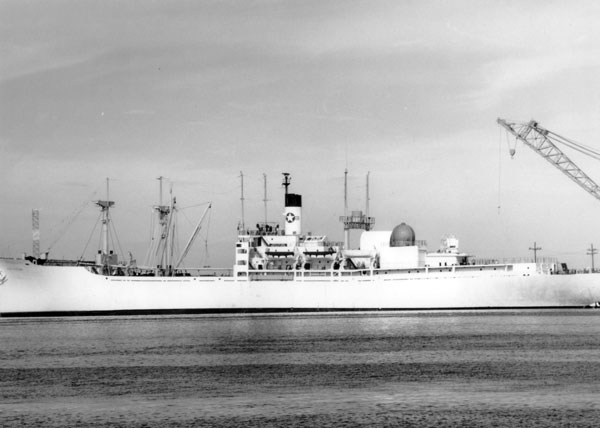
Twin Falls Victory (T-AGM-11)
- Acquired and transmited trajectory data, weather and telemetry in real time
- Carried FPS-16 radar
- 11 March 1960 Contract awarded to modify for tracking
- 14 November 1969 – Deactivated
General Callan (ARIS 1); General Taylor (ARIS 2)
- Advanced Range Instrumentation Ships
- Radar provided simultaneous trajectory and target signature data on a primary and two secondary targets
- C-band 30 foot parabolic reflector with cassegrainian horizontal and vertical focal point feed system
- L-band and X-band shared 40 foot parabolic antenna which has an 18 foot solid center to reflect l- and x-bands
- Telemetry had a 30 foot parabolic antenna
- 24 June 1961 – Contract awarded for $70.3 million
- 15 November 1961 – Ships became operational
- 1 May 1963 – General Callan renamed USNS General H. H. Arnold and General Taylor renamed USNS General Hoyt S. Vandenberg
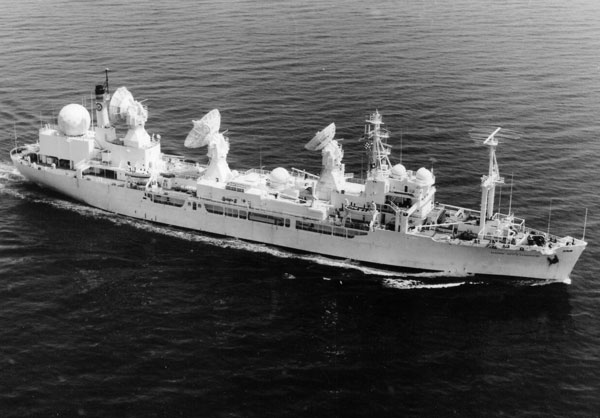
USNS Hoyt S. Vandenberg (T-AGM-10); USNS General H. H. Arnold (T-AGM-9)
- Sophisticated missile tracking ships
- 4 September 1963 – JC-130 aircraft made a successful air recovery of a dummy data package from the deck of the USNS Hoyt S. Vandenberg
- 1982 – USNS H.H. Arnold deactivated in 1982
- 1983 – USNC Hoyt S. Vandenberg deactivated
- 27 May 2009 – USNS Hoyt S. Vandenberg sunk as an artificial reef 7 miles off Key West
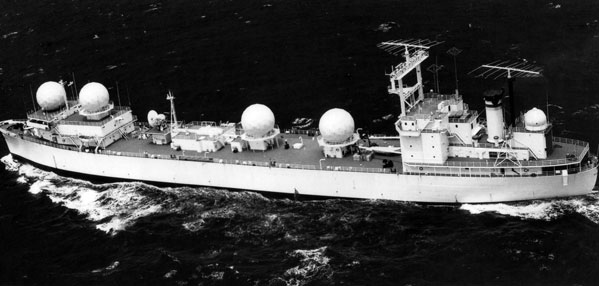
USNS Redstone (T-AGM-20); USNS Vanguard (T-AGM-19); USNS Watertown (T-AGM-6); USNS Mercury (T-AGM-21); USNS Huntsville (T-AGM-7)
- Apollo Instrumentation Ships
- Performed tracking, telemetry and communication functions for Apollo lunar missions
- Replaced the Timber Hitch class ships
- 11 October 1966 – USNS Vanguard accepted at the Eastern Test Range
- 17 March 1967 – USNS Vanguard transferred to the Western Test Range
- 18 January 1967 – USNS Mercury accepted at the Western Test Range
- 19 July 1967 – USNS Watertown accepted at the Eastern Test Range
- 18 August 1967 – USNS Huntsville accepted at the Eastern Test Range
- 20 September 1967 – USNS Redstone accepted at Western Rest Range
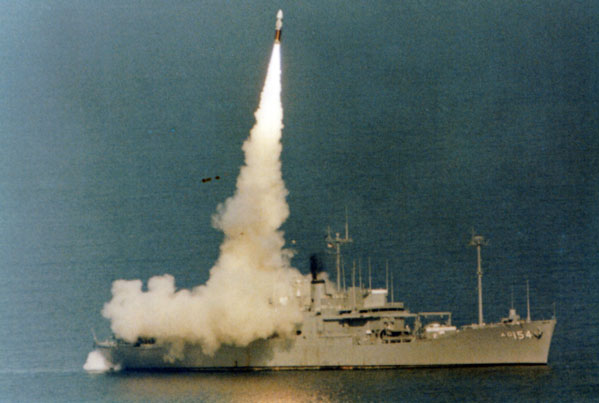
USNS Observation Island (T-AGM-23)
- 1953 – Commissioned as the Empire State Mariner
- 1953 – Transferred to the Navy for conversion into a seagoing launching pad for submarine ballistic missiles
- 2 February 1959 – Arrived to support the Polaris testing program
- 27 August 1959 – First Polaris launch from Observation Island
- 20 January 1964 – Final Polaris launch
- Total Polaris launched – 25
- After final Polaris launch, the ship served as a Launch Area Support Ship (LASS)
- 16 December 1969 – First Poseidon launch from Observation Island
- 24 March 1970 – Final Poseidon launch
- Total Poseidon launched – 3
- 1972 – Ship returned to the reserve fleet
- 1982 – USNS Observation Island joined Eastern Test Range as a range instrumentation ship mainly supporting the Cobra Judy Program
- October 1995 – Cobra Judy program was transferred to AFTAC
USNS Waters (T-AGS-45)
- Navigation Test Support Ship
- 26 May 1993 – Commissioned
- Supported Trident submarine navigation system testing and ballistic missile flight test support services
- Replaced the USNS Vanguard and USNS Range Sentinel
USNS Range Sentinel (T-AGM-22)
- 20 September 1944 – Commissioned USS Sherburne (APA-205)
- 3 August 1946 – Decommissioned
- Converted to a Missile Range Instrumentation Ship
- Same size as Range Tracker
- 21 October 1971 – Placed in service
- 14 November 1971 – Arrived to support the Poseidon Program
- 12 June 1997 – Taken out of service
USNS Range Tracker (T-AG-160)
- 27 July 1960 – Redesignated T-AGM-1
- In January 1969 – Eastern Test Range planned the ship to provide range safety for Poseidon launches
- 27 September 1969 – Taken out of service
- New Down Range Support Ship (DRSS).

USNS Howard O. Lorenzen (T-AGM-25)
- Equipped with a massive radar system originally known as Cobra Judy replacement (CJR). CJR was later designated Cobra King when it became operational in 2014. This radar system tracks foreign ballistic missiles to ensure compliance with strategic arms treaties.
- Replaced missions performed by similar tracking systems on the USNS Observation Island for SLBM launches
- Named after an Naval Research Laboratory (NRL) electrical engineer
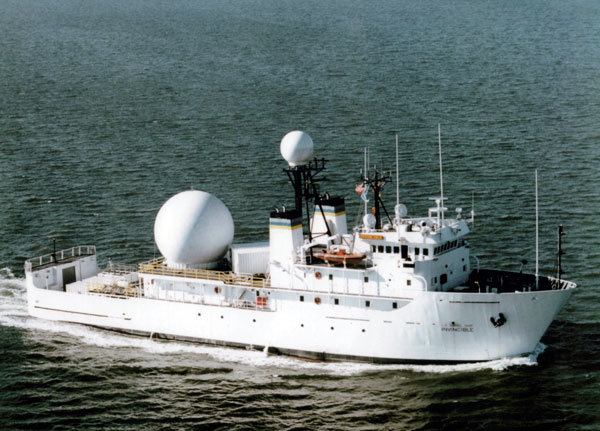
USNS Invincible (T-AGM-24)
- Missile Range Instrumentation Ship
- Cobra Gemini dual band, X-band and S-band radar
Recovery Ships
The recovery ships did not necessary operate on the Eastern Range, but are included because of their important association with launches made from Cape Canaveral Air Force Station or Kennedy Space Center.
- USS Escape
- First Jupiter nose cone recovered
- USS Strong
- 9 September 1959 – Recovered first Mercury capsule
- USS Lake Champlain
- 5 May 1961 – Recovered first Mercury manned capsule
- 19 January 1965 – Recovered unmanned GT-2 capsule
- 21 August 1965 – Recovered GT-5 capsule
- USS Randolph
- 21 July 1961 – Recovered second manned Mercury capsule
- USS Stormes
- 29 November 1961 – Recovered MA-5 capsule with primate
- USS Noa
- 20 February 1962 – Recovered MA-6 capsule
- USS Pierce
- 24 May 1962 – Recovered MA-7 capsule
- USS Wasp
- 3 June 1965 – Recovered GT-4 capsule
- 4 December 1965 – Recovered GT-7 capsule
- 15 December 1965 – Recovered GT-6 capsule
- 3 June 1966 – Recovered GT-9 capsule
- USS Mason
- 16 March 1966 – Recovered GT-8 capsule
- USS Guadalcanal
- 18 July 1966 – Recovered GT-10 capsule
- 3 March 1969 – Recovered Apollo 9 capsule
- USS Guam
- 12 September 1966 – Recovered GT-11 capsule
- USS Bennington
- 9 November 1967 – Recovered unmanned Apollo 4 capsule
- USS Essex
- 11 October 1968 – Recovered Apollo 7 capsule
- USS Yorktown
- 21 December 1968 – Recovered Apollo 8 capsule
- USS Princeton
- 18 May 1969 – Recovered Apollo 10 capsule
- USS Hornet
- 16 July 1969 – Recovered Apollo 11 capsule
- USS Iwo Jima
- 17 April 1970 – Recovered Apollo 13 capsule
- USS New Orleans
- 9 February 1971 – Recovered Apollo 14 capsule
- 25 September 1973 – Recovered Skylab 3 capsule
- 8 February 1974 – Recovered Skylab 4 capsule
- 24 July 1975 – Recovered Apollo-Soyuz Test Project (ASTP) capsule
- USS Okinawa
- 7 August 1971 – Recovered Apollo 15 capsule
- USS Ticonderoga
- 27 April 1972 – Recovered Apollo 16 capsule
- 19 December 1972 – Recovered Apollo 17 capsule
- 22 June 1973 – Recovered Skylab 2 capsule